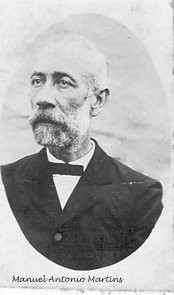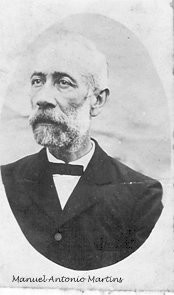The story of Manuel António Martins [1771?-1845] in Cabo Verde begins in 1793, when at the age of twenty-one as master of a vessel laden with casks of wine from Faial in the Azores. The vessel was the Sumaca, she was a sloop which is a small one-masted ship. The Sumaca was owned by a Mr. Borralho, allegedly the vessel was damaged in a storm off the Canary Islands and blown southward to Cabo Verde. Martins made a quick getaway with the vessel and cargo and used his gains to commence an inter-island commerce in the archipelago, an enterprise in which he was remarkably successful.

In 1793, Martins married a daughter of Aniceto António Ferreira, the Azorean Capitão-mor [commandant] of Boa Vista. The couple had sixteen children, seven sons and nine daughters. Their sons became involved in their father’s multifarious shipping, slave-trading, and political activities. Meanwhile, the sons of the archipelago’s morgados competed to marry Martins’s daughters and female relatives.
Manuel António Martins was born in the city of Braga, Portugal to João António Martinez Cosqueiro [from Spain] and Bernarda de Autrello [Italian], they migrated from Asturias, Spain to Braga where Manuel António Martins was born.
Manuel António Martins was Governor of Cabo Verde [1834-1835], Archeiro-Mor of the Royal House, Consul and Vice-Consul of the United States, owner of the Salinas [Salt beds], monopoly on the export of Urzella. He ordered the construction of the tunnel to access the Salinas and the first railway line in Portuguese Africa on the Island of Sal. As Governor he established the piping of fresh water to the City of Praia and also to the village of Nova Sintra, Brava. He became the wealthiest and most prominent man in Cabo Verde. He was the founder of Pedra de Lume and the town of Santa Maria and also populated the islands of Sal and São Vicente. He also built the Fort of Duke of Bragança that is located in the islet in front of the City of Sal Rei in Boa Vista. What is written above is not the entire story of Manuel António Martins, there are a lot more details to how this man came to dominate the economic and political system of Cabo Verde.
Portugal emerged from the Napoleonic Wars virtually bankrupt, with its ruler and court living in exile in Brazil. During the decades following, Portugal experienced chronic economic and political crises that distracted attention from colonial affairs, especially regarding such unprofitable colonies as the province of Cabo Verde. Once Britain closed the Senegal and Gambia rivers to slave vessels, slave caravans from the interior of western Africa rerouted south to the Casamance, Cacheu, Geba, and Grande rivers, where Portuguese, Luso-Africans, and Cabo Verdeans prospered as middlemen supplying slave vessels of many nations. Everywhere in western Africa, legitimate traders colluded with slavers. Cabo Verde became the advance base for illicit commerce with western Africa, both for slavers and for legitimate traders engaged in smuggling goods at colonial settlements. Notoriously prominent in the slave trade, legitimate trade, and other lucrative enterprises was Manuel António Martins.
In Sal Rei, Martins dispensed fabricated Portuguese vessel registries and other documents to slavers seeking to avoid capture by the Royal Navy. He colluded with colonial officials and with merchants and political influentials in Portugal. The illegal slave trade flourished to the profit of Martins and corrupt colonial officials, while the province was starved of revenues to support the colony’s civil, military, and ecclesiastical establishments and maintain and repair public buildings, forts, and other government properties.
During the 1810s and 1820s, São Tiago had adequate rainfall, and Praia’s convenient location and inexpensive provisions made it a popular revictualing port of call for merchantmen, whalers, and other vessels plying the South Atlantic and for slavers, legitimate traders, and men-of-war bound for West Africa. American seafarers were prominent among the slavers and legitimate traders who visited Cabo Verde in growing numbers.
In December 1818, another player arrives in Cabo Verde Samuel Hodges Jr., of Stoughton, Massachusetts, settled at Praia as a commission merchant and U.S. consul, and except for brief visits back to the United States, he stayed there with his family until his death in 1827.
Soon after arriving in Cabo Verde, Hodges became associated with Martins as a business partner and invaluable mediator with Portuguese officials. As the U.S. Consul he began to exercise the functions of U.S. consul, including appointing vice-consuls for several islands. Foremost among them was Manuel A. Martins, whom Hodges made the U.S. vice-consul for Boa Vista. With Martins and Hodges working together, European and Eurafrican traders living in western Africa dispatched vessels to Praia to obtain American tobacco, lumber, and other products and arrange for American vessels to deliver cargoes at French and British colonial ports in collusion with local officials or at places of rendezvous; later, these goods would be smuggled into colonial settlements or carried up rivers aboard the schooners, sloops, and canoes that linked western Africa’s markets.
The Portuguese government’s lack of commitment and capability to suppress the slave trade or punish corrupt colonial officials was especially manifested in the governorship of António Pusich (1818–1821) of Italian nationality, born in the “Republic of Ragusa,” who exceeded most governors of Cabo Verde in enterprise and initiative. Pusich married Mrs. Anna Maria Isabel Nunes, a Portuguese aristocrat, and secured Portuguese citizenship and an officer’s commission in the Portuguese navy. From 1801 to 1811, he and his family resided at Ribeira Brava on the island of São Nicolau in a post especially created for him: naval superintendent for Cabo Verde, independent of the authority of governors and colonial officials.
In May 1819, five months after assuming the governorship, Pusich established a fishing enterprise, with Manuel António Martins and some of his associates on Boa Vista. The funds, however, were soon squandered, promoting hostility between Governor Pusich and Martins. Hostilities between Pusich and Martins escalated again in 1820 when the governor accused Martins of scheming to sell the islands of Sal and São Vicente to three Englishmen trading at Bathurst: Thomas Barber, William Waterman, and Edward Bocock. Likewise allegedly interested was a Frenchman named Dèves whose trading establishment at Saint-Louis developed into the firm of Maison Dèves-Chaumet. Manuel António Martins retaliated the following year by exploiting to his advantage the political transformations in Portugal: in May 1821, he incited a mob action in Praia, joined by soldiers in the garrison, that removed Pusich from the governorship. Pusich’s downfall was a delayed consequence of the 1820 liberal revolution in Portugal that had been galvanized by economic, political, and nationalistic grievances.
Always poised to seize an opportunity for self-advancement, on March 21, 1821—seven months after the Porto garrison mutinied- Manuel António Martins organized a demonstration at Sal Rei on behalf of liberals and against Governor Pusich’s “despotic rule.” João Cabral da Cunha Goodolphim joined in the demonstration despite having been appointed Boa Vista’s commandant by Pusich in May 1820 following the retirement of Martins’s father-in-law, Aniceto António Ferreira. In appointing Goodolphim the commandant of Boa Vista, Pusich doubtless expected him to curtail Martins’s influence. Goodolphim had previously served as interim commander of Cacheu from 1815 to 1818, and during that time, he probably collaborated with Martins in slaving ventures, just as he would do while commandant of Cacheu from 1823 to 1826.
The unprecedented political activism at Boa Vista orchestrated by Martins encouraged similar initiatives by the inhabitants of other islands. Growing unrest culminated on May 1, 1821, when a mass turnout of Praia’s population, joined by soldiers in the garrison, deposed Governor Pusich. With his family, he took refuge on the island of Maio. Pusich was supplanted by a junta provisoria (provisional council), which administered the archipelago for the next year and a half (from May 1821 to January 1823). Martins joined the junta and skillfully increased his influence.
Over decades, Manuel António Martins increased the salt production of Ilha do Sal. In 1796, he dispatched slaves to create salinas and dig wells to sustain themselves and goatherds on the waterless, windswept wasteland. In 1805, Governor António Coutinho de Lencastre appointed Martins as Sal’s administrator, and in 1808, he granted him the privilege of collecting customs duties. During the 1820s, Martins undertook to exploit the salt-producing potential of Pedra Lume, Sal’s extinct 406-meter-high volcanic cone.
The salt was transported in carts propelled by sails along rail tracks to be loaded on vessels at a pier several kilometers away. Donkeys pulled the empty rail carts back to Pedra Lume. In September 1829, Martins received authorization to transport 100 to 150 slaves from Bissau and Cacheu to labor at Sal’s salinas and to engage in fishing to feed the workers. In 1834, he founded the settlement of Santa Maria das Dores (Saint Mary of Sorrows) which was also known as Porto Martins on the southern tip of the island.
In December 1833, Martins’s close friend Francisco Simões Margiochi, the minister of marine, appointed him prefect [prefeito] of the province of Cabo Verde and Guiné, the civilian title being a liberal innovation replacing military governorships. Martins also benefited from lobbying on his behalf by other individuals whose influence he had cultivated for years. Manuel António Martins was the only person to serve as a prefeito, while the prefect Manuel António Martins attempted to move the capital from Praia to Sal Rei but he was not successful. The government abolished the title in April 1835, instead dispatching governors-general who exercised both military and civil authority. Martins continued to prosper in numerous enterprises, including slave trading, and he maintained surpassing influence and powers of intimidation concerning Cabo Verde’s inhabitants. After his death in July 1845, his business affairs were carried on by his widow, children, and proliferating descendants.
___________________________________________________________________________
Sources
Faria, Luis António, Suzana Abreu, and Américo C. Araújo. Cabo Verde Terra de Morabeza: Uma Viagem Atraves de Sua Historia e Cultura. Valrico: LAF Enterprises, 2012.
George E. Brooks (2010-12-10). Western Africa and Cabo Verde, 1790s-1830s: Symbiosis of Slave and Legitimate Trades. Authorhouse. Kindle Edition.
http://www1.umassd.edu/specialprograms/caboverde/salhist.html


Where in Italy is his mother from? If you can find out/tell me it would really help with my research!
LikeLike
Hi greeat reading your blog
LikeLike
This guy was nothing but a slave trader who became wealthy thru the exploitation of Africans. To me, he was nothing short of being another Portuguese Hitler.
LikeLike
Those are some strong words, but we are all entitled to our opinions.
But I would not have called him a Portuguese Hitler, as many people that lived during that time took some part in the slave trade. He was a man of his time, we can not take our morals of today and try to impose it on people that lived in the past. Thank you for commenting and please continue to follow and comment in the future.
LikeLike
hi can anyone tell me how to get in contact with the sourses
LikeLike
Hello Adilson,
The sources are stated at the bottom of the article.
LikeLike
Great job! It seems that trough his economic power, Mr. Martins might have exerted a tremendous influence on the make up of the political spectrum. This is a clear evidence of the struggle between political and economic powers. Which is shaping which?
LikeLike
I believe that it is a symbiotic relations between economic and political power
LikeLike